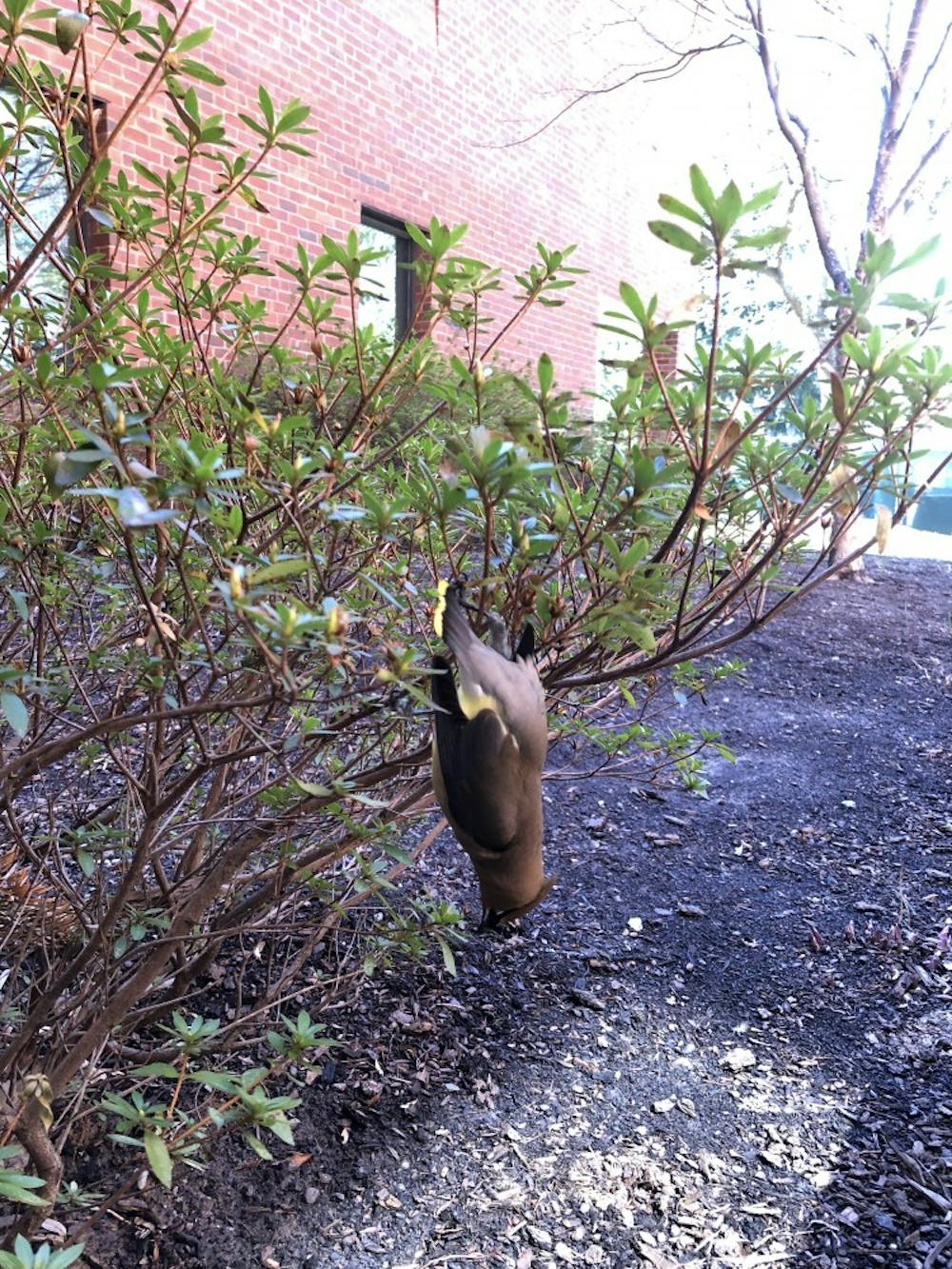Various bird species have been fatally slamming into windows in the Charlottesville area and around Grounds. These deaths may be linked to alcohol poisoning from eating tree berries.
A recent incident occurred at Charlottesville High School in which various cedar waxwings — medium-sized birds with mostly brown plumage and yellow-tipped tail feathers — were found dead after flying into the windows of the school.
“I could stand underneath [glass windows] and just watch as they would collide,” Walker Catlett, a junior at Charlottesville High School and avid bird watcher, said in an email.
According to Catlett, intoxication — a likely result of consuming berries from a nearby Japanese pagoda tree — heightens the chances of these birds’ fatal crashes. The seeds of Japanese pagoda berries are also poisonous and are presumed to induce death once ingested by the cedar waxwings.
Asst. Biology Prof. Jessamyn Manson said certain species of birds — including cedar waxwings — may be attracted to berries as they are biologically berry-eaters.
“That’s where they get their carbohydrates from,” Manson said. “It’s their food source. What’s different in this case is this fermentation component where the berries themselves have started to, essentially, go bad.”
According to Manson, birds may not be capable at distinguishing between fresh, nutritious berries and fermented ones. In fermented berries, yeasts break down the carbohydrates and generate a byproduct of ethanol — a compound found in alcoholic drinks.
“Alcohol is a toxin,” Manson said. “So what you start to see are the same kinds of behaviors you see in people. You start to see lack of coordination and issues with motor skills. Animals will get slower and clumsier.… It’s harder for them — in a bird’s case — to fly straight and recognize obstacles that come into their path.”
Similar fatalities have occurred at the University. Third-year College student Anne Marie Saunders, who is studying biology with a concentration in organismal and environmental diversity, observed several dead cedar waxwings near Ruffner Hall in March of this year.
While walking to class around noon, Saunders noticed a fallen cedar waxwing on the sidewalk close to a large window on Ruffner Hall and about 30 other live cedar waxwings perching on a Japanese pagoda tree. She later saw another cedar waxwing hanging off of a nearby bush and one on the ground.
Saunders said she believes the birds were flying into the large window, about 10 yards from the Japanese pagoda tree. She also suspects more delayed waxwing deaths.
“I volunteered at a wildlife refuge for a while and I know that birds can often fly into windows and have slow brain bleeds that don’t cause fatalities until a little bit later,” Saunders said. “So even when there’s not instantaneous death, there often will be delayed fatalities from window crashes.”
However, these casualties are not specific to cedar waxwings, nor are they exclusively dependent on intoxication from fermented berries.
First-year College student Jo Klansek witnessed dead gray catbirds — medium-sized birds with gray plumage and orange undersides — near the Balz-Dobie dorm. Klansek said in an email that she has not seen berry bushes near Balz-Dobie and that the bird likely died by “running its body into the window of my dorm.”
Catlett has also marked various species’ crashes — unrelated to berry consumption — at Charlottesville’s YMCA.
“I've found strikes at the YMCA since last October including a Tufted Titmouse, White-throated Sparrow, Dark-eyed Junco, Hermit Thrush, a Cedar Waxwing, and now a Cardinal,” Catlett said. “These strikes aren't because of intoxication, and have to do with the large reflective windows. Birds aren't able to perceive reflective windows as a solid surface and instead see it as an extension of their habitat.”
According to Saunders, while some berries may be particularly intoxicating — such as those of the Japanese pagoda — glass windows are typically the greater threat. In the urban setting, fatalities often occur when birds mistake windows’ reflections of the blue sky for the actual open sky.
Saunders has noted the glass passageway between Wilson Hall and New Cabell Hall as a potentially dangerous location. She found a couple dead birds of unknown species in this area a few times.
Manson also deemed windows as the main hazard — especially for already drunk birds.
“In nature, if we weren’t out in a campus or in a small city, this would not be a serious issue,” Manson said. “These birds would deal with the intoxication over time and recover just like anybody would if they consumed too much ethanol. The problem is what they do afterwards and if they’re surrounded by windows, surrounded by buildings, they’re confused and not coordinated.”
To prevent further window strikes, Charlottesville High School attached poster paper onto windows as a temporary solution and plans to put tempera paint on the windows, according to Catlett. Manson, who has an issue with cardinals running into the windows of her home, has put up dark decals on her windows.





